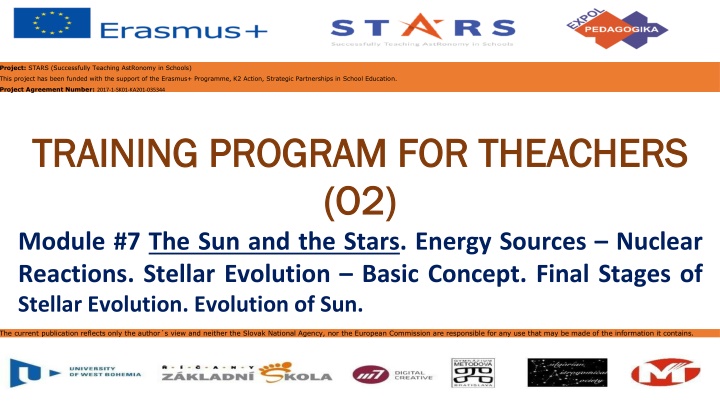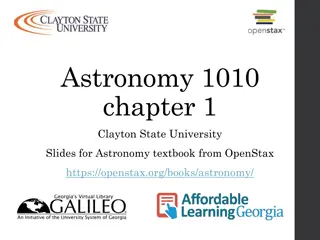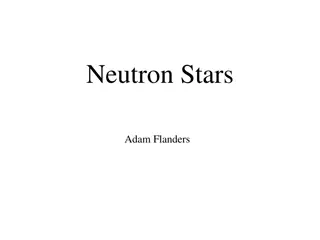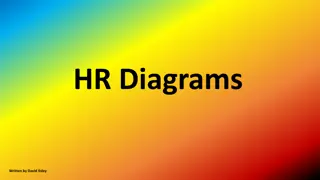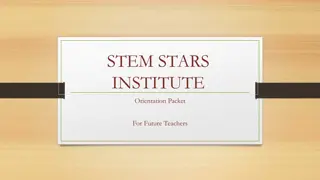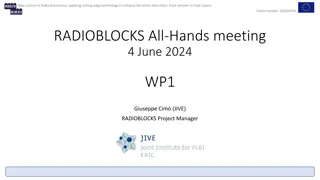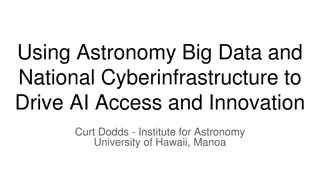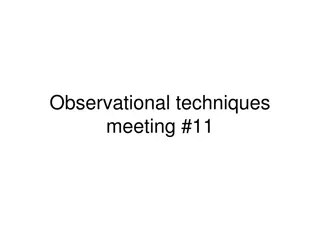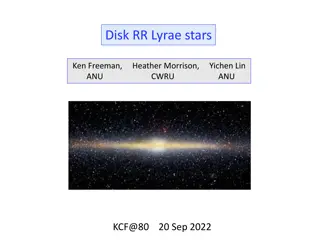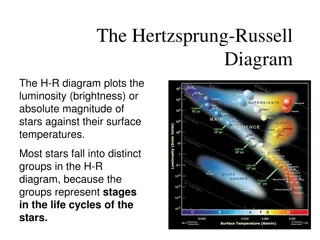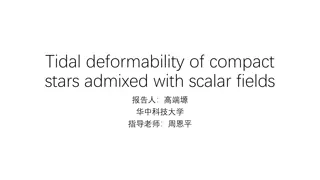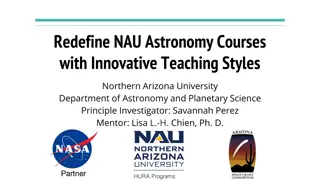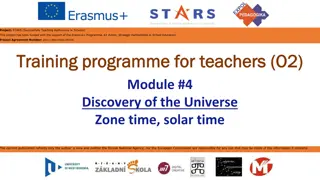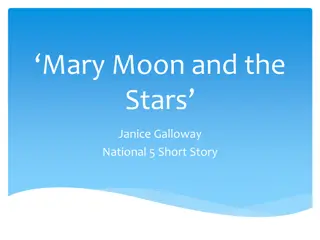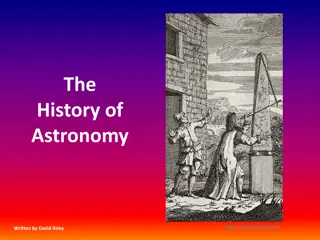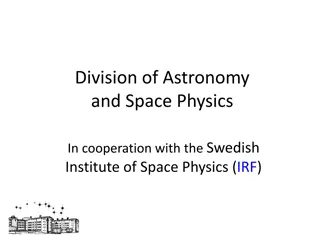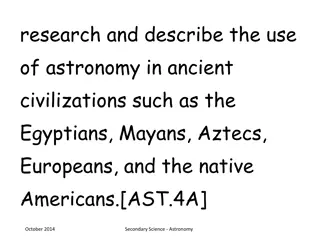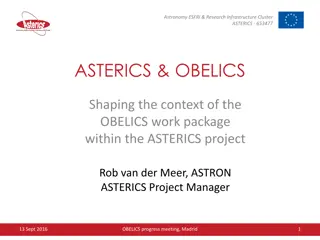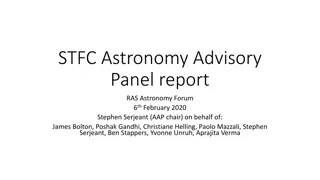STARS Project: Teaching Astronomy in Schools
STARS project aimed at enhancing astronomy education in schools. Learn about the training program for teachers, modules covering topics like the Sun and stars, and practical exercises for students. Discover resources, online platform, and concept for astronomy education. Dive into stellar evolution, celestial bodies, and more with this innovative approach
Download Presentation

Please find below an Image/Link to download the presentation.
The content on the website is provided AS IS for your information and personal use only. It may not be sold, licensed, or shared on other websites without obtaining consent from the author.If you encounter any issues during the download, it is possible that the publisher has removed the file from their server.
You are allowed to download the files provided on this website for personal or commercial use, subject to the condition that they are used lawfully. All files are the property of their respective owners.
The content on the website is provided AS IS for your information and personal use only. It may not be sold, licensed, or shared on other websites without obtaining consent from the author.
E N D
Presentation Transcript
Project: STARS (Successfully Teaching AstRonomy in Schools) This project has been funded with the support of the Erasmus+ Programme, K2 Action, Strategic Partnerships in School Education. Project Agreement Number:2017-1-SK01-KA201-035344 TRAINING PROGRAM FOR THEACHERS TRAINING PROGRAM FOR THEACHERS (O2) (O2) Module #7 The Sun and the Stars. Energy Sources Nuclear Reactions. Stellar Evolution Basic Concept. Final Stages of Stellar Evolution. Evolution of Sun. The current publication reflects only the author s view and neither the Slovak National Agency, nor the European Commission are responsible for any use that may be made of the information it contains.
STARS project intro 1.STARS Methodological Handbook for Teachers ready-to-use resource for teachers 2.STARS Training Program for Teachers innovative and comprehensive approach 3.STARS Online Platform with examples of good practice and opportunities for discussions and exchange 4. STARS Concept for Astronomy Education Program International Conference in Senec 2020 project-stars.com The current publication reflects only the author s view and neither the Slovak National Agency, nor the European Commission are responsible for any use that may be made of the information it contains.
STARS modules Galactic Neighbourhood. Sun and the Stars. Milky Way Galaxy and other galaxies. The Universe. Observatories. #1 #2 #3 Constellations. Motion of Celestial Bodies. Newton's laws of Gravitation. #6 #7 #8 #4 #5 Space Exploration. Solar System. #9 #10 The current publication reflects only the author s view and neither the Slovak National Agency, nor the European Commission are responsible for any use that may be made of the information it contains.
Structure of the modules There are several topics in each module. Each topic contains: A brief introduction and key words; Theoretical part for the teacher - provides the basic information, necessary for the planning a lesson on that topic (and links to additional information in some cases). ! THESE ARE NOT READY-TO-USE LESSONS! Practical exercises and activities for the students -ready for use in the classroom (in most cases) and with answers provided where applicable. The current publication reflects only the author s view and neither the Slovak National Agency, nor the European Commission are responsible for any use that may be made of the information it contains.
How to work with the content 1 1. Read carefully the theoretical part for the teacher. 2. Should questions arise, look for the answers in the supplementary materials on the web-page of the project (http://project-stars.com/?lang=bg) or other Internet sites. Attention! Make sure the sources are reliable! 3. Prepare the theoretical part of the lesson. The current publication reflects only the author s view and neither the Slovak National Agency, nor the European Commission are responsible for any use that may be made of the information it contains.
How to work with the content 2 4. Read carefully the practical exercises and their answers. 5. Should questions arise, look for answers in the supplementary materials , on the project s website (http://project-stars.com), or other internet sites. Attention! Make sure the information is reliable! 4. Depending on the theoretical content of your lesson, choose appropriate pracical activities to use. You can look for additional exercises in the supplementary materials or at the webpage of the project (http://project-stars.com/?lang=bg), or other internet sites. Attention! Make sure the information is reliable! The current publication reflects only the author s view and neither the Slovak National Agency, nor the European Commission are responsible for any use that may be made of the information it contains.
How to work with the content 3 7. Keep in mind that some of the activities require materials that should be available during the lesson. 8. We reccomend you try out the activities yourself before presenting them in the classroom. Based on yours students ages and abilities, you might need to modify the activities (either to make them easier or more difficult). However make sure to keep them correct in terms of physics. 9. You can give parts of, or whole exercises as homework. The current publication reflects only the author s view and neither the Slovak National Agency, nor the European Commission are responsible for any use that may be made of the information it contains.
Module 7 content 7.1. Energy sources nuclear reactions. 7.2. Stellar evolution basic concept. 7.3. Final stages of stellar evolution. 7.4. Evolution of Sun. The current publication reflects only the author s view and neither the Slovak National Agency, nor the European Commission are responsible for any use that may be made of the information it contains.
Theoretical part content Nuclear reactions: why the stars shine; what are the processes generating the hige amount of energy; what is the duration of these processes for different type of stars. Stellar evolution basic concept: the birth of stars, early stages of evolution, Hertzspung-Russell diagram. Theory and observations of the stellar evolution. Final stages of stellar evolution: evolution of stars with different masses after the Main sequence. The Sun as a star. Solar evolution. The current publication reflects only the author s view and neither the Slovak National Agency, nor the European Commission are responsible for any use that may be made of the information it contains.
List of practical activities 7.1.1 Arrange the words and find the names. 7.1.2 Generate the iron stellar core (Internet game). 7.1.3 How the elements in stars are created? 7.2.1 To construct the H-R diagram. 7.2.2 How big are the stars? 7.3.1 The path of the Sun through the H-R diagram. 7.4.1. To track the sunspots. The current publication reflects only the author s view and neither the Slovak National Agency, nor the European Commission are responsible for any use that may be made of the information it contains.
Activity 7.1.1: Arrange the words and find the names. Easy and simple! Methodical part: module 7, topic 1. Materials: list of names with scrambled letters (suppl. 7.1.1). Procedure: the students have to find the names and to compose physically correct sentences with them. For pupils scrambled answers and the sentences to be composed together with the teacher. The exercise could be given for homework if necessary. The current publication reflects only the author s view and neither the Slovak National Agency, nor the European Commission are responsible for any use that may be made of the information it contains.
drohygen tionacre liumhe onfusi onir ergyen tonopr netrinuo parasetion clenuus mentele sropecs boncar The current publication reflects only the author s view and neither the Slovak National Agency, nor the European Commission are responsible for any use that may be made of the information it contains.
drohygen tionacre liumhe onfusi onir ergyen tonopr netrinuo parasetion clenuus mentele sropecs boncar hydrogen reaction helium fusion iron energy proton neutrino separation nucleus element process carbon The current publication reflects only the author s view and neither the Slovak National Agency, nor the European Commission are responsible for any use that may be made of the information it contains.
Activity 7.1.2: Generate the iron stellar core Methodical part: module 7, topic 1. Materials: smartphone or computer with Internet connection Procedure: https://dimit.me/Fe26/ Detailed description in module 7, topic 1 The current publication reflects only the author s view and neither the Slovak National Agency, nor the European Commission are responsible for any use that may be made of the information it contains.
Activity 7.1.3: How the elements in stars are created? Methodical part: module 7, topic 1. Materials: the list is given in module 7, topic 1 Procedure: Detailed description in module 7, topic 1 The current publication reflects only the author s view and neither the Slovak National Agency, nor the European Commission are responsible for any use that may be made of the information it contains.
Activity 7.2.1 To construct the H-R diagram. Methodical part: module 7, topic 2. Purpose: Students should get an idea for the sizes of stars and the relation between the size, mass and the position on the Hertzsprung-Russell diagram. Materials: Plasticine with different colors: red, yellow, blue, white, black; plastic board to work on; the image of the Hertzsprung-Russell diagram from the theoretical part. The current publication reflects only the author s view and neither the Slovak National Agency, nor the European Commission are responsible for any use that may be made of the information it contains.
Activity 7.2.2. How big are the stars? Methodical part: module 7, topic 2. Purpose: The students should get an idea about the sizes of stars and understand the relation between mass and radius of stars. Materials: Table with data; calculator. The current publication reflects only the author s view and neither the Slovak National Agency, nor the European Commission are responsible for any use that may be made of the information it contains.
Activity 7.3.1: The path of the Sun through the H-R diagram. Methodical part: module 7, topic 4. Purpose: At the end the students should make sense of the evolutionary meaning of the Herzsprung-Russell diagram. Materials: The image of the H-R diagram. The current publication reflects only the author s view and neither the Slovak National Agency, nor the European Commission are responsible for any use that may be made of the information it contains.
Activity 7.3.1: Continuation: Procedure: Sketch the evolutionary path of the Sun from its current position to the end of its life on the H-R diagram. Answer: the picture on the right. The current publication reflects only the author s view and neither the Slovak National Agency, nor the European Commission are responsible for any use that may be made of the information it contains.
Activity 7.3.1: Continuation: Questions: 1. Will the Sun become a neutron star at the end of its life? Why? [Answer: The Sun would not become a neutron star because its mass is not enough.] 2. When does a star end its life like a black hole? [Answer: If after a supernova stage, the stellar remnant has a mass greater than 3 solar masses, the gravitational collapse continues until it becomes a black hole.]. The current publication reflects only the author s view and neither the Slovak National Agency, nor the European Commission are responsible for any use that may be made of the information it contains.
Activity 7.4.1. To track the sunspots. Methodical part: module 7, topic 4. Purpose: The students will work with real images of the Sun that professional astronomers work with. They will be able to track the changes in sunspots for a short period of time and will be able to determine the speed at which they move on its surface. The current publication reflects only the author s view and neither the Slovak National Agency, nor the European Commission are responsible for any use that may be made of the information it contains.
Activity 7.4.1. Continuation: Materials: In the supplementary materials you will find images of the Sun in 5 days, obtained from the solar observatory SOHO. Also a map of the Sun, which shows the coordinates - length and latitude. The current publication reflects only the author s view and neither the Slovak National Agency, nor the European Commission are responsible for any use that may be made of the information it contains.
Conclusions, results check 1 Feed Forward: Base your plans for the next lessons on the results of the students: Difficulty of the lessons: depending on student comprehension of the material and level of completion of the activities. Preparation: Clear and well appointed goals of the lesson and activities. When the goal is well understood, the attention towards a task/material is easier and more effective. Approach toward the material: What would be the correct approach that would help the student comprehension and activity completion. The current publication reflects only the author s view and neither the Slovak National Agency, nor the European Commission are responsible for any use that may be made of the information it contains.
Conclusions, results check 2 Selfevaluation: selfdiscipline, steering and control of the activities. Individual approach: Individual approach and guidance. Check: How did I do? Individual evaluation of the student s work, pertaining to the specific activity and goal. Must contain information about the advance (or lack of) the student has made and to guide them to achieve the goals and standards. The current publication reflects only the author s view and neither the Slovak National Agency, nor the European Commission are responsible for any use that may be made of the information it contains.
